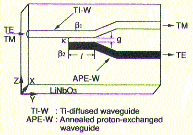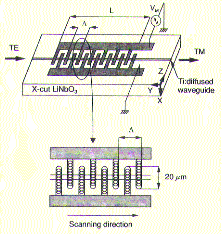| There has been considerable effort in development of LiNbO3 waveguide devices
for the communication use, including branching-waveguide type switches,
mode splitters, mode converters, wavelength filters, and so on. Most of
these devices were tested at visible or near infrared light; otherwise,
the basic design concepts of the devices are applicable for the communication
at 1.3/1.5micron. In addition, the thermooptic switches in ion-exchanged
glass waveguides was proposed for the first time in this lab., which led
to popular switching devices in silica planar light circuits. One of the
recent works is the compact and efficient TE-TM mode splitter, using directional
coupling between heterogeneous waveguides in LiNbO3. The mode splitting
ratio is >12dB, and the coupler length was only <1mm at a wavelength
of 0.8micron, which is short enough for optical integration. The other
is the TE-TM mode conversion type wavelength filters in LiNbO3. The interdigital
electrodes are formed by the laser-beam periodic-dot writing technique
which can control the electrodes period with an accuracy of the order of
nanometer. The eight filters are integrated on a LiNbO3 chip with the center-wavelength
spacing of 5.4 nm. Combination of the mode converters and wavelength filters
will also provide a new class of WDM device. |

